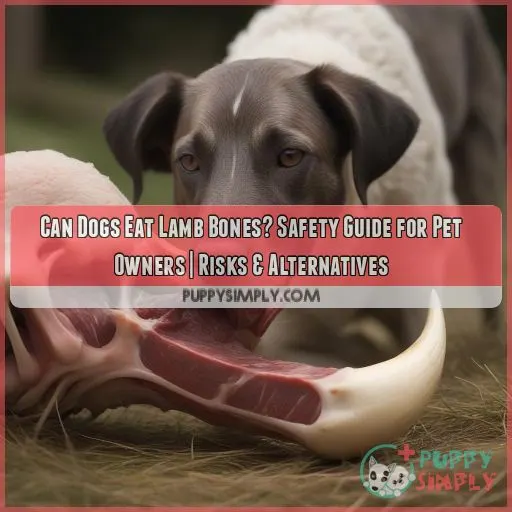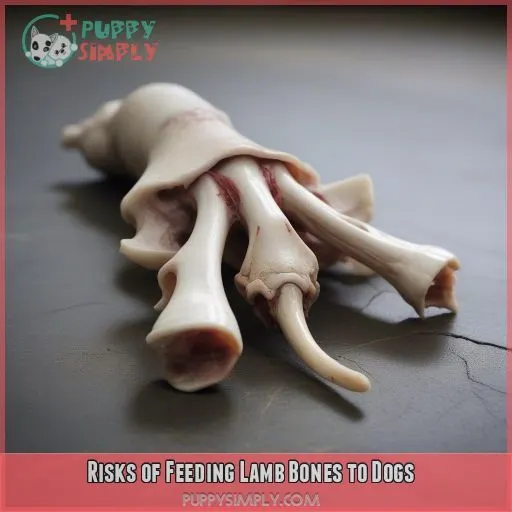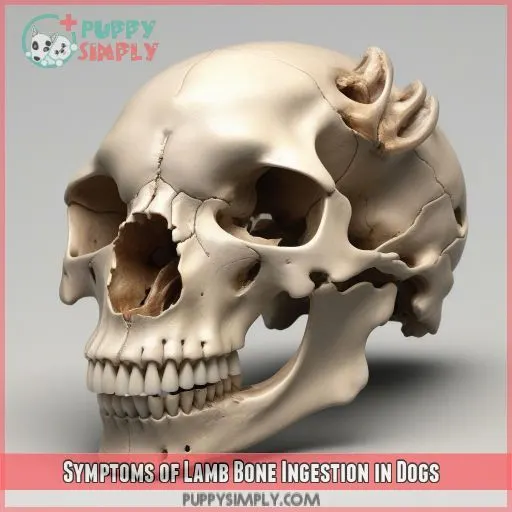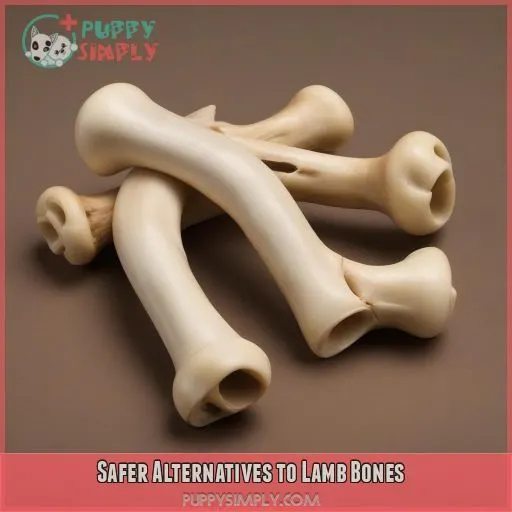This site is supported by our readers. We may earn a commission, at no cost to you, if you purchase through links.
 You are wondering if it’s OK to feed your dog lamb bones? You are rightly concerned as a responsible pet owner. While dogs do love to chew upon bones, not all may be safe for use as a reward or as a snack.
You are wondering if it’s OK to feed your dog lamb bones? You are rightly concerned as a responsible pet owner. While dogs do love to chew upon bones, not all may be safe for use as a reward or as a snack.
Lamb bones can pose severe dangers to health, including possible choking hazards and internal injuries to your furry friend.
Inside this guide, we are going to discuss the risks associated with feeding lamb bones to dogs, safer alternatives to use instead, and give tips on proper bone handling.
Your dog’s safety is paramount, so let’s dive into what you need to know
Table Of Contents
- Key Takeaways
- Can Dogs Eat Lamb Bone?
- Risks of Feeding Lamb Bones to Dogs
- Symptoms of Lamb Bone Ingestion in Dogs
- Safer Alternatives to Lamb Bones
- Proper Bone Handling and Supervision
- Resting the Dog’s Digestive System
- Monitoring and Follow-Up
- Acceptable Bone Options for Dogs
- Consequences of Feeding Cooked Lamb Bones
- Signs of Gastrointestinal Obstruction or Damage
- Importance of Veterinary Intervention
- Frequently Asked Questions (FAQs)
- Can a dog eat a cooked lamb bone?
- Why can’t dogs eat lamb?
- What bones can dogs eat?
- Is raw lamb safe for dogs?
- Can a dog eat a lamb bone?
- Can dogs eat lamb?
- Can dogs eat raw lamb shank bones?
- How do you know if a dog eats cooked lamb bones?
- How long does it take for dogs to digest lamb bones?
- Can puppies safely chew on lamb bones?
- Are there breed-specific considerations for feeding lamb bones?
- How often can I give my dog lamb bones?
- Do lamb bones provide any nutritional benefits for dogs?
- Conclusion
Key Takeaways
- Cooked lamb bones are a no-go zone for your furry friend – they’re more dangerous than a cat in a room full of rocking chairs! These brittle bad boys can splinter and cause internal injuries faster than you can say "fetch."
- Raw lamb bones might be okay in moderation, but always keep your eagle eyes on your pup while they’re chomping away. It’s like letting your teenager borrow the car – trust, but verify!
- If you’re looking for safer alternatives, consider rawhide chews, Nylabones, or dental treats. They’ll keep your dog happier than a squirrel with a lifetime supply of acorns, without the risk of an emergency vet visit.
- Should your four-legged friend sneak a forbidden lamb bone feast, watch for signs like lethargy, reduced appetite, or the dreaded tummy troubles. If you spot these red flags, don’t wait – get your pup to the vet faster than a greyhound chasing a mechanical rabbit!
Can Dogs Eat Lamb Bone?
You shouldn’t feed your dog lamb bones due to the risks involved. While dogs may love chewing on bones, lamb bones can splinter and cause serious internal injuries. They might also lead to intestinal blockages or cause gastrointestinal issues like vomiting and diarrhea**.
If your furry friend has ingested lamb bones, watch for symptoms like lethargy, reduced appetite, and abdominal pain.
Instead of lamb bones, consider safer alternatives such as rawhide chews, Nylabones, or dental treats designed specifically for dogs. Always supervise your pup when giving them any chew toy, and remove it if it becomes small enough to swallow.
There’s more to learn about keeping your canine companion safe and satisfied
Risks of Feeding Lamb Bones to Dogs
You should be cautious when considering giving lamb bones to your dog. Cooked bones can splinter and cause internal injuries, while bone fragments may lead to intestinal blockage and gastrointestinal issues such as nausea, vomiting, and diarrhea
Cooked Bones Can Splinter and Cause Internal Injuries
You might think cooked lamb bones are a tasty treat for your pup, but they’re a recipe for disaster. When heated, these bones become brittle and can splinter like shards of glass.
As your dog chews, these sharp fragments can wreak havoc on their digestive tract, causing painful internal injuries.
You might even notice blood in their saliva – a red flag that requires immediate attention
Bone Fragments Can Lead to Intestinal Blockage
When your furry friend chows down on lamb bones, it’s not just splintering you need to worry about. Bone fragments can be sneaky troublemakers, potentially causing intestinal blockages.
The size and type of bone matter, as does how long your pup’s been chewing.
Keep a watchful eye on your dog, and if you notice any unusual behavior, don’t hesitate to ring up your vet for a consultation
Potential for Gastrointestinal Issues Like Nausea, Vomiting, and Diarrhea
Apart from intestinal blockages, lamb bones can do much other damage to your dog’s digestive system. If your furry companion has been helping themselves to such dangerous treats, you may come across symptoms like nausea, vomiting, or diarrhea.
It’s not just lamb bones; beef bones can be harmful to dogs as well. Digestive discomfort and upset stomachs can be avoided by considering safer alternatives and ensuring bone safety is always a top priority.
Prevention is essential, but early intervention is crucial if symptoms appear
Symptoms of Lamb Bone Ingestion in Dogs
If a dog were to ingest a lamb bone, one would then need to keep an eye out for lethargy, reduced appetite, vomiting, diarrhea, and abdominal pain. These could tell of digestive problems or internal injuries; therefore, monitor your pet keenly and contact your veterinarian if you observe any of these symptoms.
Lethargy
After ingesting lamb bones, your dog might become lethargic. This isn’t just a nap; it’s a concerning sign of digestive issues.
You’ll notice your pup’s usual zest for life dwindling. They might lie around more, showing little interest in play or walks.
This lethargy, often accompanied by vomiting and diarrhea, is your dog’s way of saying, "Something’s not right." Don’t ignore it – it’s time to act
Reduced Appetite
If your dog’s lethargy persists, you’ll likely notice a reduced appetite as well. This is a common sign of gastrointestinal issues caused by ingesting lamb bones. Your pup may show difficulty eating or become withdrawn, refusing their usual meals.
Watch for a sore or contracting abdomen, excessive whining, and whimpering. These symptoms indicate potential bone safety concerns and digestive health problems.
Don’t ignore these warning signs – they’re your dog’s way of communicating discomfort
Vomiting
If your dog’s eaten lamb bones, watch out for vomiting. It’s a telltale sign of trouble. You might see your furry friend retching or bringing up their last meal.
This isn’t just an upset tummy – it could signal bone fragments causing havoc. Keep an eye on the vomit for blood or bone pieces.
If you’re worried, don’t wait. Call your vet promptly for expert advice
Diarrhea
If your dog is vomiting and diarrhea, this is a definite indication that lamb bones have irritated their digestive system. Diarrhea quickly turns into dehydration, so the condition of the dog needs to be kept under constant monitoring. Here are some key points to remember:
- Offer small amounts of water frequently
Watch for signs of dehydration like dry gums or sunken eyes.
- Consider a bland diet of boiled chicken and rice
• Avoid treats or regular food until symptoms improve
Keep an eye out for any straining when your dog tries to pass feces
Abdominal Pain
If your dog’s eaten lamb bones, watch for signs of abdominal pain. They might whine, pace, or assume a "prayer position" with their front legs down and rear end up. Don’t ignore these signs – they could indicate serious digestive issues or even intestinal blockage.
| Pain Level | Signs | Action |
|---|---|---|
| Mild | Restlessness | Monitor |
| Moderate | Whining, Pacing | Call Vet |
| Severe | Vomiting, Lethargy | Emergency Vet |
Safer Alternatives to Lamb Bones
Instead of risking your dog’s health with lamb bones, consider safer alternatives like rawhide chews, Nylabones, or dental treats designed specifically for canines. These options can satisfy your dog’s chewing instinct while minimizing the dangers associated with real bones, providing a safer way to keep your pet entertained and promote dental health
Rawhide Chews
While lamb bones are risky, your pup’s urge for chewing is much safer when satisfied by rawhide chews. Such natural dog treats give edible options to satiate their impulse to gnaw.
Rawhide alternatives could support dental health and add nutritional value when consumed safely. They can also come with risks, so it’s always best to supervise your dog and ensure that only good-quality products are purchased
Nylabones
Nylabones are much safer for satisfying your fur baby’s urge to chew than lamb bones. Durable toy designs like these for dogs aren’t easily destructible, even for the most aggressive chewer. They’re long-lasting and safe, unlike beef bones or chicken bones for dogs that might splinter in the stomach, which could eventually cause intestinal blockage.
Great for puppy training, pet-sitting situations, or keeping your pup preoccupied while administering medications, always supervise during chew time for ultimate safety
Dental Treats Specifically Designed for Dogs
While Nylabones are great, dental treats offer another safe alternative to lamb bones. These specially designed chews cater to your dog’s gnawing habits while promoting dental health. They’re a win-win, satisfying your pup’s urge to chew and keeping their teeth clean. Just remember to factor them into your dog’s daily calorie intake.
- Reduces plaque and tartar buildup
- Freshens breath naturally
- Comes in various sizes and flavors
- Helps massage gums and clean between teeth
- Often contains ingredients that support overall oral health
Proper Bone Handling and Supervision
When giving your dog a bone, always supervise them closely and never leave them unattended. Remove the bone once it becomes small enough to swallow, and consider using a muzzle if your dog tends to scavenge or gulp down treats too quickly
Never Leave Dogs Unattended With Bones
Always supervise your dog when giving him a bone. Dogs can be overzealous chewers, and unsupervised bone time can quickly become trouble.
Consider the pup’s size and chewing habits in picking the right bones and remember that alternative chews or edible options can often be safer.
Offering bones has potential dental benefits, but safety always comes first. Be nearby to ensure that your furry friend enjoys his treat responsibly
Remove Bones When They Become Small Enough to Swallow
As your dog chews, keep a close eye on the bone’s size. Once it’s small enough to swallow, it’s time to take it away. This prevents choking hazards and potential intestinal blockages. Remember, bone size matters for your pup’s safety and enjoyment.
- Monitor your dog’s chewing habits to gauge when the bone becomes too small
- Consider the nutritional value against the risk as the bone shrinks
- Balance recreational chewing benefits with dental health concerns
Use a Muzzle if Necessary to Prevent Scavenging
If your dog’s a notorious scavenger, consider using a muzzle during walks or off-leash time. It’s not cruel; it’s a smart precaution to prevent your furry friend from gobbling up dangerous items.
Muzzles are especially useful for unattended dogs or those with a history of scavenging
Resting the Dog’s Digestive System
To rest your dog’s digestive system after ingesting lamb bones, withhold food for 12-24 hours while offering small amounts of water frequently. Once you reintroduce food, start with a bland diet of boiled chicken and rice, and consider adding fiber like psyllium to aid digestion
Withhold Food for 12-24 Hours
If your dog has been eating lamb bones, rest their digestive system. Stop feeding them food for 12-24 hours so the stomach rests and settles. This stoppage provides the digestive tract with an opportunity to rejuvenate, due to which further problems can be avoided to a great extent.
After this period, start introducing a small amount of easy or bland diet such as boiled chicken and rice; you can add psyllium to it to regulate their system.
Keep in mind that every pup is different, so monitor closely
Offer Small Amounts of Water Frequently
When resting your dog’s digestive system, offer small amounts of water frequently to prevent dehydration and maintain electrolyte balance. This approach helps soothe the stomach while keeping your pup hydrated. Keep a close eye on your furry friend’s water intake and symptoms.
- Use a clean, shallow bowl for easy access
- Offer ice cubes as an alternative to liquid water
- Consider a pet fountain to encourage drinking
Feed a Bland Diet of Boiled Chicken and Rice
After offering small amounts of water, it’s time to introduce a bland diet. Boiled chicken and rice are your go-to options for resting your dog’s gastrointestinal system. This combination is easy to digest and gentle on the stomach.
Start with small portions, gradually increasing as your pup’s condition improves
Add Fiber to the Dog’s Diet (e.g., Psyllium)
Adding fiber to your dog’s diet can help soothe their digestive system after a bone mishap. Psyllium, a natural fiber supplement, is your go-to option.
It’s like a gentle broom for your pup’s gut, sweeping away troubles. Mix a teaspoon into their food to boost digestive health and get things moving smoothly again.
Your furry friend’s gastrointestinal well-being will thank you!
Monitoring and Follow-Up
Monitor your dog for a few days immediately after having the lamb bones, as this would go the extra mile to determine if they’re recovering or if veterinary intervention needs to occur later on. Keeping an eye on their appetite, energy levels, and bowel movements is essential.
Observe the Dog’s Condition for Several Days
Keep a close eye on your dog for several days following his lamb-bone incident. This is no time to let your guard down. Continue to be vigilant for any lingering symptoms or new ones that might pop up.
Of course, you should also consider nutritional alternatives to bones at this stage in your pup’s recovery.
This healing journey isn’t over yet, and you’re the captain at the helm of their health management
Monitor Appetite, Energy Levels, and Bowel Movements
Keep a close eye on your dog’s appetite, energy levels, and bowel movements after they’ve chewed on lamb bones. Watch for any changes in their chewing behavior or interest in food.
Monitor their energy – are they as playful as usual?
Check their stools for consistency and any signs of blood. Remember, bone size and marrow content can affect digestion.
If you notice any concerning changes, don’t hesitate to contact your vet
Acceptable Bone Options for Dogs
While cooked lamb bones pose risks, raw lamb bones can be a safe option for your dog when given under supervision. Other acceptable choices include raw beef bones and large, heavy bones that are harder for dogs to break or swallow whole
Lamb Bones (raw Only)
If you’re considering giving your dog lamb bones, stick to raw options only. Raw lamb bones can provide valuable enrichment and dental health benefits. They’re a great source of bone marrow, which dogs love.
Chewing on bones can be an excellent bonding activity and even aid in training. Just remember to supervise your pup and choose bones that are appropriate for their size and chewing habits
Beef Bones
Even though raw lamb bones are safe to eat, there’s no denying that beef bones are always a great option. It’s denser and stronger, which makes it ideal for heavy-duty chewers. These beef bones have essential goodness in them in the form of bone marrow, so they’re excellent for your dog’s health. Consider the following while opting for beef bones:
- your dog’s size and chewing habits
• Density and nutrient content of the bone
• Breed suitability to different types of bones
Always supervise and select appropriate size bones for safe chewing.
Large, Heavy, and Hard Bones
While beef bones are a popular choice, large, heavy, and hard bones offer additional benefits for your dog’s dental health and mental stimulation. These bones have higher bone density and a more substantial bone composition, making them safer options. Consider the bone shape and size when selecting, ensuring it’s appropriate for your dog’s jaw strength and size.
| Bone Type | Benefits | Considerations |
|---|---|---|
| Marrow Bones | Rich in nutrients | Monitor consumption |
| Knuckle Bones | Long-lasting chew | May be too hard for some |
| Femur Bones | Excellent for large breeds | Can cause tooth fractures |
| Rib Bones | Satisfying chew | Risk of splintering |
| Shoulder Bones | Good bone density | Supervise closely |
Consequences of Feeding Cooked Lamb Bones
While there are many benefits of raw bones, cooked lamb bones have considerable risks for your furry friend. You may feel like you’re pampering the pup with this treat, but these reasonably innocent tidbits can become a recipe for disaster once cooked.
Cooked bones also become brittle and often splinter, sometimes causing awful injury to the inside mouth, esophagus, or intestines of your dog. It’s like giving your pooch a mouthful of sharp toothpicks – not a pleasant experience!
Moreover, bone fragments may cause gastrointestinal blockages, and what might’ve been just a simple treat could end up as a costly visit to the vet.
Instead of jeopardizing your dog’s health for this dangerous indulgence, find safer alternatives in the form of raw bones or specially designed dental chews.
Keep in mind that when it comes to bone suitability, there’s always your vet to fall back on. They’ll help you choose options that will keep your pet’s tail wagging without compromising their welfare
Signs of Gastrointestinal Obstruction or Damage
If your dog has ingested lamb bones, watch for signs of gastrointestinal obstruction or damage. Be alert for choking, coughing up blood, excessive salivation, blood in saliva, and difficulty eating, as these symptoms may indicate serious complications
Choking/coughing
If you see that your dog chokes or coughs after having lamb bones, then it’s time to take fast action. These could be some hazardous signs. Watch out for:
• Persistent gagging or retching
• Difficulty swallowing
- Pawing at the mouth
- Anxious pacing
- Excessive drooling
Do not just wait to see if it passes. It was always important to correctly supervise your dog and pick the right-sized bones. Consider raw bone safety or alternative treats, and always check with your vet for anything you’re unsure about.
Coughing Up Blood
If your dog has been coughing up blood after chewing lamb bones, then that could be a warning sign for some severe damage to the gastrointestinal tract. This alarming symptom is one of the possible internal injuries because of bone splinters or obstruction. Don’t waste any minute—call your vet immediately.
Canine digestion and safety from bones go hand in hand. Keep in mind that there exists a variety of treats out there that won’t compromise your puppy’s gastrointestinal health.
In case of doubt, always consult a veterinarian
Excessive Salivation
If you have been noticing your dog coughing up blood, excessive salivation might be the next red flag. Just because your pup does this drooling fest doesn’t mean he daydreams about treats. Drooling in canines often means that they feel discomfort or nausea brought on by those lamb bones.
Watch for other early signs of dehydration, such as excessive panting. Staying hydrated is essential, so ensure your fur baby always has access to fresh water
Blood in Saliva
If you’ve noticed blood in your dog’s saliva after they’ve chewed on lamb bones, it’s a red flag you can’t ignore.
This could signal serious issues like swollen gums, tongue discoloration, or even fractured teeth. Bad breath and tooth decay might also accompany these symptoms.
Don’t wait – it’s time to put down the bones and pick up the phone to call your vet
Difficulty Eating
If your dog’s having trouble eating after munching on lamb bones, it’s time to pay attention. Bone fragments can cause intestinal blockage, leading to gastrointestinal issues.
You might notice your furry friend struggling to swallow or chew. This could be a sign that cooked bones have splintered, causing discomfort.
Don’t ignore these warning signs – they’re your pup’s way of saying, "Houston, we have a problem!
Importance of Veterinary Intervention
If you have observed any signs of gastrointestinal upset in your dog after they consumed lamb bones, don’t delay consulting with a veterinarian. Your quick action may just save a life.
Keep in mind that you’re your pet’s first line of defense and responsible for keeping them safe. Be prepared for emergencies by having your vet’s number on file and knowing where the nearest animal hospital is.
Prevention is always better than cure; take preventive measures such as keeping the bones out of reach and supervising your pet during meal times.
Your veterinarian will be your biggest ally in maintaining perfect health conditions. They can give you, as an individual, advice on what’s safe to chew and what’s not, and on good nutrition.
If ever in doubt about your dog’s condition after lamb-bone consumption, err on the side of caution and seek professional help. Your furry friend’s well-being is worth every precaution
Frequently Asked Questions (FAQs)
Can a dog eat a cooked lamb bone?
You shouldn’t give your dog cooked lamb bones. They’re dangerous, as they can splinter and cause serious injuries. Stick to safe alternatives like raw bones or specially designed chew toys to keep your furry friend happy and healthy
Why can’t dogs eat lamb?
Dogs can eat lamb, but not cooked bones. They’re dangerous because they splinter easily, risking injury to your pup’s mouth, throat, or digestive tract. Stick to raw, meaty bones or safer chew alternatives for your furry friend’s safety
What bones can dogs eat?
You can safely give your dog raw edible bones like beef or lamb ribs. Avoid cooked bones, as they splinter easily. Chewable bones for recreation are also great options. Always supervise and remove when they’re small enough to swallow
Is raw lamb safe for dogs?
Like a shepherd guarding his flock, you must protect your furry friend. Raw lamb bones can be safe for dogs, but you’ll need to supervise closely. They’re a good source of nutrients and can help clean teeth
Can a dog eat a lamb bone?
You shouldn’t give your dog lamb bones. While raw bones can be safe, cooked ones splinter easily and pose serious health risks. Instead, opt for specially designed chew toys or treats that satisfy your pup’s natural urge to gnaw
Can dogs eat lamb?
Yes, lamb is OK for dogs to eat. It’s a very nutritional type of protein and is easily digestible. Serve it cooked, without bones or excess fat. Provide small portions at first to ensure your puppy tolerates it well. Always consult your vet for dietary advice.
Can dogs eat raw lamb shank bones?
You’d be barking mad to say no to your furry friend to offer them raw lamb shank bones. They’re full of so many nutritional elements while they clean stuff off the teeth. Make sure they’re large enough not to choke, and always be on guard when your pup goes into the chewing session.
How do you know if a dog eats cooked lamb bones?
Watch for signs like vomiting, lethargy, or abdominal pain. You’ll notice changes in your dog’s behavior, appetite, and bowel movements. If you suspect they’ve eaten cooked lamb bones, don’t wait – contact your vet immediately
How long does it take for dogs to digest lamb bones?
Time’s ticking for your pup’s digestion! Raw lamb bones take 24-48 hours to break down, while cooked ones can linger dangerously. You’ll want to keep a watchful eye for any signs of distress during this period
Can puppies safely chew on lamb bones?
You shouldn’t give puppies lamb bones. They’re too hard for developing teeth and can cause dental damage or choking. Instead, offer puppy-specific chew toys or treats designed for their age and size. Always supervise your pup during chew time
Are there breed-specific considerations for feeding lamb bones?
Like a puzzle with unique pieces, breed considerations matter. Larger breeds can handle bigger bones, while smaller dogs need appropriately sized options. You’ll want to match the bone size to your dog’s jaw strength and chewing habits for safety
How often can I give my dog lamb bones?
You can give your dog raw lamb bones once or twice a week. Limit the chewing time to 10-15 minutes per session. Always supervise and remove the bone if it becomes small enough to swallow
Do lamb bones provide any nutritional benefits for dogs?
Imagine a nutrient-filled treasure chest unlocked for your dog’s good health—raw lamb bones loaded with calcium, phosphorus, and marrow nutrients. They act as nature’s toothbrush for health. Would you want to provide them? Occasionally, following the given safety guidelines for your pup’s well-being.
Conclusion
Feeding lamb bones to dogs feels like walking on eggshells—the danger lurks. You learned about the hazards, from choking and internal injuries to more, so now you know why it’s essential first to ask, "Can dogs eat lamb bones?" before offering them as treats.
Now, armed with safer alternatives, proper bone-handling procedures, and heightened awareness of complications, you’re much better equipped to protect your furry friend









